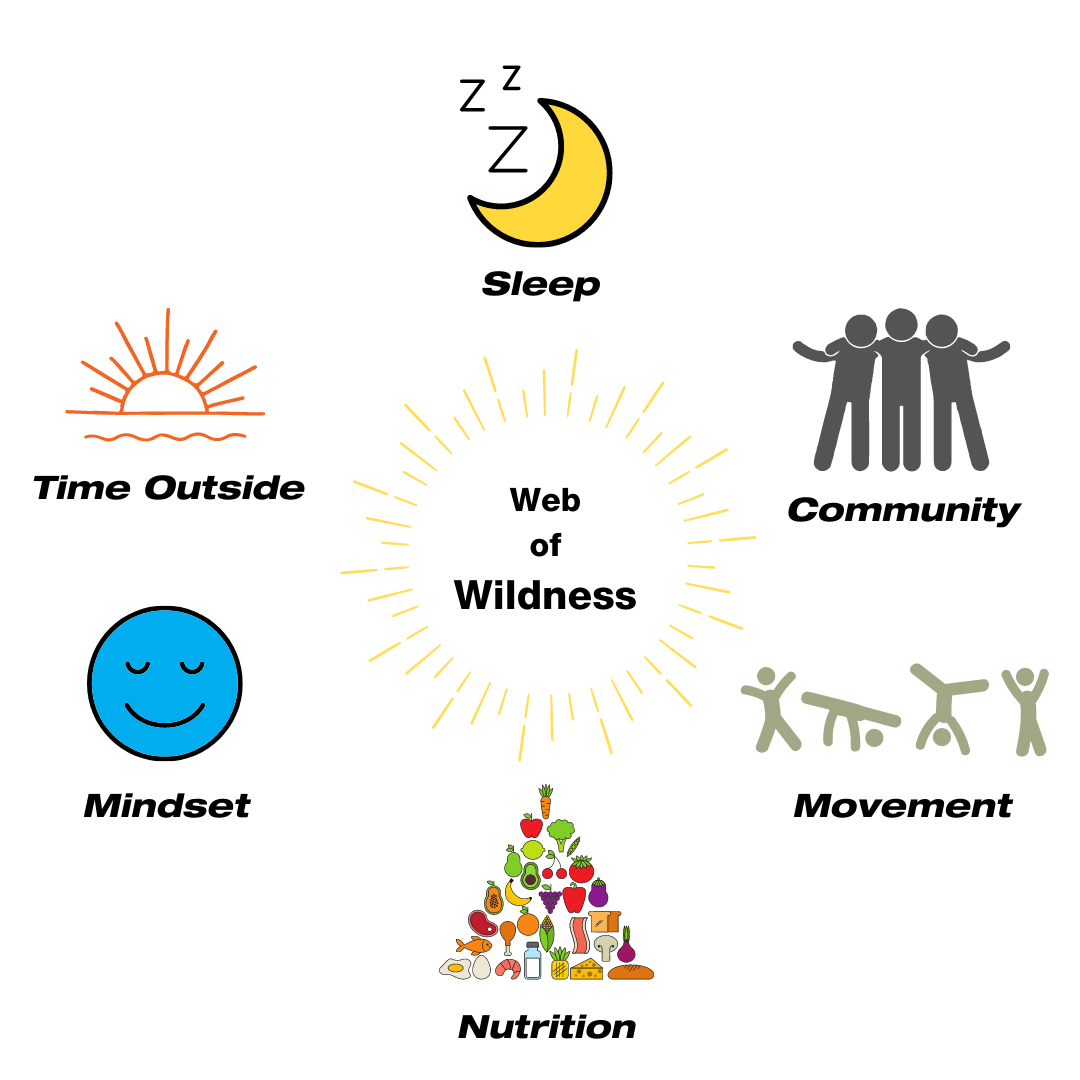6 Elements of a Fitness Practice
Hey Wild,
I was out on the trail a few days back and was thinking about how I structure my “fitness practice”. I also recorded a podcast on this topic if you’d rather listen than read. Specifically, I was pondering the frequency with which I approach the six facets of training listed below. In other words, how much volume of each element do I generally take on. Not surprisingly, if I were to be coaching an individual, this is how I would also structure their programming. Before we venture farther, the six elements of a fitness practice are:
- Nutrition
- Movement
- Range of Motion
- Strength
- Power
- Intensity
These are listed in the order of frequency or volume that you should be “practicing” each element. It’s not that you have to 100% “win” Nutrition before moving on the Movement or Range of Motion. Instead, think of this as a guide that can help you balance out your training and make sure that you are not over-exposed to any one element. If you're eating garbage, but crushing the intensity, you might want to rebalance.
Nutrition
Eat real food making sure to get enough energy and protein to support your activity level. We all know that sound nutrition is vital for optimal health and wellness. Unfortunately, there is an extremely powerful industrial food machine that wants to convince us that their packaged goods, pills, and supplements are somehow better than the recipes of mother nature. Don’t believe them. Make as many meals yourself as possible. Bring your lunch to work by taking on a “Tupperware Titan” mindset. If it comes in a package or has more than one ingredient - don’t buy it. Purge the packaged, food-like substances from your home and be free of their insidious temptation. You will not eat what is not in your home. Stay disciplined.
Movement
I really think of movement as a non-exercise activity. It’s not a workout - it’s just moving. Think of walking, hiking, swimming, cycling - forms of monostructural movement. It could also be play, dance, or even sport. Move as much as you possibly can throughout the day and interestingly, you might notice that you actually have more energy. From an evolutionary perspective, walking is the number one form of movement. Whenever I go camping this becomes crystal clear. In the absence of the modern landscape the main activities you do are walk around, get up and down off the ground, and carry stuff around (maybe we should come up with a training program with those three activities as the focus…?). Movement frequency and volume should be maximized to the degree that life allows. An excellent movement goal is 30-minutes of walking every single day. If possible, do this first thing in the morning and set the momentum for the rest of the day.
Range of Motion
I break Range of Motion (ROM) down into mobility and flexibility. Mobility is focused on the movement potential of a joint while flexibility refers to the lengthening ability of a muscle. You need to practice both to get the maximal benefit. What is the benefit you ask? Access to your body. The more range of motion you have the greater your access to your own movement potential. In my own fitness practice, ROM was often overlooked because to be honest, it just wasn’t sexy. However, I now make it a non-negotiable priority to my training. I suggest you do the same. Train ROM every single day. 5-10 minutes in the morning and 5-10 minutes in the evening done consistently will lead to exceptional results. Bonus points if you can throw in a mid-day sesh. What should you do? Here’s my top three mobility and flexibility exercises:
Mobility: Squat Hold, Shoulder Rotations, T-Spine Rotation.
Flexibility: Pancake Stretch, Runner’s Lunge, Forearm Flexor Stretch.
This video I made a while back uses pocket monkii in combination with a wild-yoga-flow for a blend of mobility and flexibility.
Lastly, anything posted by Dr. Kelly Starrett on The Ready State channel is legit.
Strength
Strength is your ability to generate force. And remember, strength training does not just train your muscles - your entire body gets stronger. Muscles, bones, tendons and ligaments all respond to strength training. You can get stronger by moving an external load or by moving your own bodyweight. As long as you are exposing yourself to the appropriate forces you will get stronger. As a rule of thumb, strength gains are optimized when working in the 3-8 reps range where those reps are hard and/or heavy. For example, you will get stronger from doing bodyweight squats only. However, you’d get even stronger by adding an external load to the same Squats or, by doing a Bulgarian Split Squat where you are now lifting your body with only one leg. You can also increase strength by utilizing tempo training and increasing your body’s time-under-tension (we will have to dive deeper into this topic in a future article). Train strength 3-5 days per week depending on your individual goals. 2-3 strength sessions per week should be the minimum.
Power
Power is how fast you can generate force. The classic distinction is between powerlifting and olympic weightlifting. Think of someone pulling a heavy deadlift. It can sometimes take them several seconds to complete the lift. Contrast this to an olympic weightlifter who completes the lift in less than a second. Power generation has a lot to do with neuromuscular efficiency - how fast can your body recruit the maximum amount of muscle fibers. The faster and more fibers recruited - the higher the power output. Because of the neuromuscular component, it can be detrimental to train power when in a fatigued state. You want to focus on quality reps and allow for adequate recovery between each set. This might mean taking several minutes between sets. Turn on a solid podcast and honor the rest period. 2-3 Power-focused sessions each week can significantly improve this facet of your fitness. They don’t need to be long sessions either. 10-15 minutes of some jumps, sprints, plyometrics is more than enough. Power up.
Intensity
I think of intensity as near-maximal output for an uncomfortable amount of time. Think of doing a Tabata sesh on monkii 360 or pretty much any workout from a Tactical Manual. Your muscles are burning, your heart rate is jacked, and your breathing is supercharged. In order for this type of session to truly be of high intensity, they need to be done less frequently. You want to treat these as an opportunity to breakthrough to a new fitness level vs something that is merely survived or completed. Don’t get me wrong, there is definitely a place for survival training, but those can be few and far between. When you’re going to go hard, go really hard. 2-3 Intensity sessions per week is the sweet spot.
In summary:
- Nutrition - win every day.
- Movement - move as much as possible every day,
- Range of Motion - practice every day. 5-10 minutes in the morning and evening will provide remarkable results.
- Strength - 3-5 days per week. Keep reps hard/heavy and in the 3-8 rep range.
- Power - 2-3 days per week. Focus on quality.
- Intensity - 2-3 days per week. Make sure it is truly intense.
I wanted to write this article because I often focused too much on #3, 4, and 5 - Strength, Power, and Intensity - without a solid foundation of Nutrition, Movement and ROM. My goal is to maintain as much capacity as I possibly can until I die and I believe following this model is the key to getting there. I want life to be something like this: wild, wild, wild, wild, wild…wild…death. By continuing to prioritize these six elements, I believe I can maximize the wildness ahead. I hope to see you out there, too.
What questions do you have?
What topics are you most interested in?
Let us know!
Stay wild out there,
-Dan




Leave a comment
This site is protected by hCaptcha and the hCaptcha Privacy Policy and Terms of Service apply.